第52話(2023/1)
Old Ways Are
Being Written Off As If They Had Never Existed
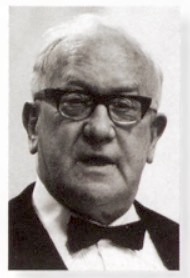 長年、 "Piping
Times" に目を通して来たので、David
Murray
という名前については、それなりに頻繁に目にしていた、という印象はあります。しかし、この方が一体どの様な方なのか?
正直、余り深く知ろうとした事はありませんでした。
長年、 "Piping
Times" に目を通して来たので、David
Murray
という名前については、それなりに頻繁に目にしていた、という印象はあります。しかし、この方が一体どの様な方なのか?
正直、余り深く知ろうとした事はありませんでした。時折目にする写真の風貌から推して、Seumas MacNeill と同年輩であろう、という事は容易に察しがつきました。そして、確か、1980年代の一時期にピーブロック・ソサエ ティーの代表(プレジデント)を務めていた様な…、といった程度の認識しかありませんでした。そもそも、この方が PS プレジデントであった事を知ったのは、1984年に PSからリリースされた James Campbell of Kilberry による "Sidelights on the Kilberry Book of Ceol Mor" の巻頭に、この方が書いていた序文の肩書がそうなっていたから。
つまりは、それなりの血筋の良い学識経験者のハイランド・パイプ愛好家という事なのでしょう。また、その名前を "Piping Times" 誌上で頻繁に目にしていたという事から、Seumas MacNeill にも近い筋の、言うなれば 「CoP マフィア」の一員だという事も容易に想像できます。
ところが、最近になってオールド・スタイルのピーブロックについてあれこれ勉強している中で、あちこちに David Murray という名前が登場する事にハタと気付きました。それも、アンチな意見では無くて、どちらかと言うと好意的。…というよりも、積極的に評価する立ち位置 で…。
最初にそれに気付いたのは、George Moss を紹介したパイプのかおり第38話の中で、この方が 1986年に John D. Burgess を伴って Moss にインタビューしている下り。自分で紹介 しておきながら余りピンと来てなかったのですが、今になって振り返ってみると、David Murray はその当時、紛れもなくピーブロック・ソサエティーのプレジデントでした。
そして、David Murray がオールドスタイルに好意的、というか、元 PS プレジデントでありながら、Kilberrism に批判的な立ち位置をとっているという事が明確に見えて来たのが、パイプのかおり第50話で詳細に紹介した Allan MacDonald の "Dustirum" のライナーに寄せている一 文です。
更にその上で「David Murray の人となりを絶対に知るべし」という想いに至ったのは、Bridget MacKenzie による "George Moss and the Fraser pipers" の記事(パイプのかおり第47話)が掲載された "Piping Times" 2015年3月号の Stuart Letford によるエディトリアルを 読んだ時です。 そこには、情けないこと極まり無い Seumas MacNeill の Moss に対する辛辣な態度と裏腹な、David Murray のごく真っ当な見解が紹介されていました。
鬼籍に入られた方の人となりを知るのに最も手短な方法は、その方の追悼記事を読む事。1921年生まれの David Murray は2017年1月 に95歳で亡くなられています。想像した通り、1917年生まれの Seumas MacNeill と4歳違いです。さすが、かなりの高齢まで生き延びたパイピング界の大御所 故でしょう、"Piping Times" 2017年2月号に Jeannie Campbell による、のべ5ページにも及ぶ長文の追悼記事が掲載されていました。
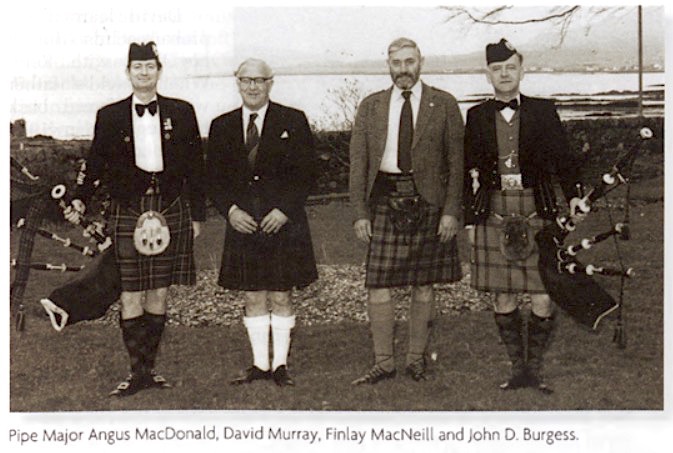 その追悼文か ら、David
Murray の生涯をかいつまんで紹介します。
その追悼文か ら、David
Murray の生涯をかいつまんで紹介します。この方は、代々続くエリート職業軍人の家系の様です。大隊の司令官だった父親がその当時に赴任していたパキスタン で生まれた後、赤ん坊の頃に英国に戻ります。その後は父親の勤務地に伴い、インバネス、エジンバラ、グラスゴー等、 ス コットランド各地を転々とします。
パイプを始めたのは10代初めで、12歳でパイプバンドに加入。1935年からは、グラスゴー高校の士官候補生 チームのパイプバンドに参加し、Robert Reid の指導を受け、個人レッスンも受ける様になります。
1938年、家族がエジンバラに戻ったとき、Reid は P/M William Ross に連絡し、David がレッスンを続ける事が出来るよう手配しまし た。
1939年、David は18歳の誕生日を迎え てすぐに軍に入隊。1941年、Queen’s Own Cameron Highlanders に配属されます。1942年、連隊はどこに向かうのか分からないまま出航し、10週間の航海の後、インドに到着。日本軍のビルマ侵攻に備えるためだったの ですが、代わりにインドが侵攻されます。David はコヒマの戦い(1944年4月〜6月)とビルマへの進攻に参加。終戦後の1946年に一旦帰国した後、日本に派遣 されて占領軍として1年間を過ごした後、マラヤにも駐留。
1952年にスコットランドに戻った後、オーストリアに短期駐留していた時に、当地、史上最高のマーチ奏者と言わ れていた Major Archie MacNab と出会い、親交を深めます。後日、Archie MacNab は David Murray について「ピーブロックとライトミュージックの両方で、今日最高の奏者の一人であることは間違いないだろう。彼の指使いはとても力強く、きれいで、フレー ジングも素晴らしい。この将校は、どんなプロのコンペティション(professional piping competition)でも、最も手ごわい競争相手となるだろう。」と語っています。実はこの最後の一文には「彼はアマチュアなので、その様なコンペ ティションに競技者として参加する事は有り得ないが、もしも、参加したとしたら…」という前置きが省略されているの だと思います。
そして、次の様な興味深い下りが続きます。「David は 1954年にスコットランドに戻り、Staff College(陸軍士官が参謀として訓練を受ける大学)に在学中、おそら Archie の証言の結果として、彼はピーブロック・ソサ エティーに参加するよう招待された。」
つまり、その当時のピーブロック・ソサエティーというのは、ハイソな会員制ク ラブそのもので、既存の会員の推薦によって、ソサエティーの方から招待されなければ入会すら出来なかった、という事が 伺えます。もちろん、プロフェッショナル・パイパーの参加などは有り得ない時代。上級国民たるアマチュアの牙城、高 級サロンだっ た訳です。
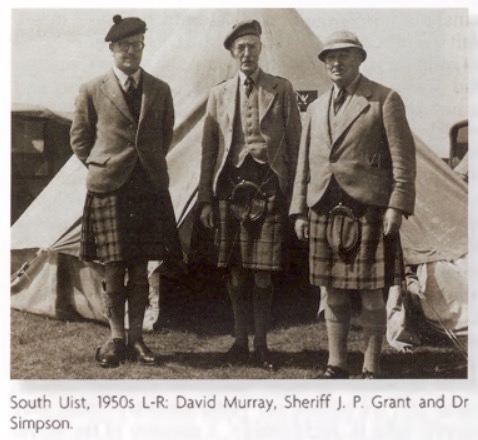 その後も、David Murray
はアマチュア・パイプ愛好家の王道を歩みます。 J. P.
Grant of Rothiemurchus の贔屓の下、1955年の Sout
Uist ハイランド・ゲームに於いて、ジャッジとしてデビュー。また、その頃から CoP と
の関わりが深くなり、Seumas MacNeill や
Duncan MacFadyen
といった講師陣の裏方を務めたりしていた様です。
その後も、David Murray
はアマチュア・パイプ愛好家の王道を歩みます。 J. P.
Grant of Rothiemurchus の贔屓の下、1955年の Sout
Uist ハイランド・ゲームに於いて、ジャッジとしてデビュー。また、その頃から CoP と
の関わりが深くなり、Seumas MacNeill や
Duncan MacFadyen
といった講師陣の裏方を務めたりしていた様です。1963年に中佐(Lieutenant Colonel)に昇進し、Queen's Own Cameron Highlanders 大隊の指揮を執ったりした後、1972年(51歳)に退役します。
1974年に The Northern Meeting のパイピング分科会の主催者の任に付 き、その後1986年まで12年間従事。その間には、イベントの開催方法についての様々な改革を行ったとの事。 1970年代には、Edinburgh Tatoo の副プロデューサーを務め、1980年代初頭には、BBCのラジオ番組 "The Noble Instrument" のパーソナリティーを務めました。
ピーブロック・ソサエティーのプレジデント就任に関する次の下りが実に興味深い所です。
"He was elected President of the Piobaireachd Society in 1982 and held that office until 1988 when he did not stand for re-election." 「1982年にピーブロック・ソサエティーの会長に選出され、1988年までその職を務めたが、再選を果たせなかった。」
この書き方から察するに、当時67歳でまださほどの歳では無かったご当人は「まだまだその職務を続ける意思が有っ たにも関わらず降ろされた」という経緯だったのでは無いでしょうか。わざわざこの様な書き方をすると言う事から、そ の時の人事はかなり揉めた、と言う事が透けて見えます。
思うに、David Murray のオールド・ スタイルに対する姿勢が、当時(も今も)多勢を占めていた保守派の 逆鱗に触れたのではないでしょうか。何しろ、5歳年長でパイピング界では先輩格の James Campbell が鬼籍に入るのは、まだまだ 先の 2004年の事ですから。
David Murray の生涯を紹介した前置きが長くなりましたが、その J.C. が居なくなった翌年の 2005年8月号 "Piping Times" に寄稿されたのが今回紹 介す るこの "Old Ways Are Being Written Off As If They Had Never Existed" という記事。"Piping Times" 2015年3月号の Stuart Letford によるエディトリアルで引用されていた元ネタです。非常に示唆に富んだ内容なので、全文を翻訳して紹介します。
| 原 文 |
日本語訳 |
|---|---|
| 'It's a long, long
time from May to December, but the days grow
short, when you reach September!’ So runs the
song. However, the days grow even shorter as
December itself approaches. I used to think that
the years from age 70 to 80 had gone past fast
enough, but the years from 80 to 90 are simply
flashing by. That being the case, I would like to set down certain influences that have been central to my personal piping philosophy before it’s too late. To my mind, the most important event that has happened over recent years has been the production by the College of Piping of the CD ‘Classics from the College’, featuring the playing and some of the teaching of Robert Reid. It illustrates a completely different and now vanished approach. To the best of my knowledge, I am Robert Reid’s last surviving pre-war pupil. Robert Reid was the star pupil of John MacDougall Gillies, and thus the last representative of the traditions of the Cameron family. Robert Reid died in 1965 at the early age of 70. As old men know, it’s easier to remember what happened and what was said to one fifty years ago, than to recall what happened last week. Having spent much of the last twenty-five years trying to describe how Robert Reid played the hiharin movement, it was with great relief that I heard him in ‘The Groat’, ‘MacSwan of Roaig’, and above all in ‘Donald of Laggan’ play it exactly as I remembered. Short ‘E’, emphasis on the ‘A’, the melody note. I realise that the star of Archibald Campbell of Kilberry is very much in the ascendant these days. From his way of writing hiharin as two even crotchets, played literally as written, derives the modern way of expressing the movement. But I suggest that this is not how Archibald Campbell intended it to be played. It seems to me that the ‘appoggiatura’ theory, applied correctly, supports Reid’s way of playing the hiharin, and from what I recall of James Campbell’s playing, which I heard only on cassette, he too dwelt on the low ‘A’. This difference in interpretation can be dismissed as a technicality, but the fact is that where the hiharin begins a phrase or ends a line in piobaireachd, which it often does, the whole scansion of the piece can be distorted when ‘E’ and ‘A’ are given equal value. This applies particularly in tunes where the hiharin is repeated two or four times in order to even up the line or phrase as in ‘The Old Men of the Shells’, ‘The Earl of Ross’s March’, and ‘Lachlan MacNeill Campbell’s Fancy’. Listen to Robert Reid playing the Urlar of ‘Donald of Laggan’ and you will see what I mean. You may also understand what I mean about his different approach. In his Revised Ceol Mor Notation, written in 1905, Charles Thomason sets out two methods of playing the hiharin, the double echo on ‘A’. He describes the modern style as the full beat or eallach, and the alternative, the broken beat with the accent on the first A, as the gairm, and deplores the disappearance of the latter. |
「5月から12月までは長い長い時間だが、
9月になると日が短くなる!」という歌がある。しかし、12月が近づくと、さらに日が短くなる。私は以
前には、70歳から80歳までは十分に早く過ぎ去ったと思っていたが、80歳から90歳は文字通りあっ
という間である。 そこで、手遅れになる前に、私の個人的パイピング哲学に影響を与えた、それなりの事柄について書き留 めておこうと思う。 近年起こった最も重要な出来事は、カレッジ・オブ・パイピングが Robert Reid の演奏と指導の一部を収録したCD "Classics from the College" を制作したことだと思う。この音源は、現在とは全く異なった、そして、今では消えてしまったピーブロッ クへの取り組み方を示している。私の知る限り、私は Robert Reid の第2次世界大戦前最後の教え子の生き残りである。 Robert Reid は John MacDougall Gillies の 一番弟子であり、つまりは、Cameron 一族の伝統を受け継ぐ、最後の代表者であった。Robert Reid は 1965年に 70歳という若さでこの世を去った。 老人は、先週のことより 50年前のことを思い出す方が簡単だという。私は、この 25年間、Robert Reid がどのように hiharin を演奏するかを説明するのに多くの時間を費やしてきたが、この音源の "The Groat" 、"Lament for MacSwan of Roaig"、 そして何よりも "Lament for Donald of Laggan" に於いて、彼が私が記憶している通りに演奏するのを聴いて、大いに安堵したものであった。つまり、"E" を短く、メロディー音である "A" を強調して…。 近年は、Archibald Campbell of Kilberry というスター的存在がとても支配的である事を実感している。彼は hiharin を2つの均等な4分音符で表記、その通りに演奏したこと から、現代の装 飾音の表現方法が導き出された。しかし、私は、これは Archibald Campbell が本 来的に意図した演奏方法では無いと考 えている。 (Kilberry の言わんとする)装飾音理論が正しく適用されれば、Reid の hiharin の 表現が支持される様な気がする。私がカセットで 聴いた James Campbell の 演奏を思い起こす限りでは、彼もまた "Low A" を強調していた。 この解釈の違いは、技術的な問題として片付けられるかもしれないが、実際、ピーブロックでは、hiharin がフレーズの最初や最後に使われることが多く、"E" と "A" が同じ長さで表現されてしまうと、曲の全体の韻律が歪んでしまう事がある。 "The Old Men of the Shells"、 "The Earl of Ross's March"、"Lachlan MacNeill Campbell of Kintarbert's Fancy" の様に、ラインやフ レーズを均等にするために hiharin が2〜4 回繰り返される曲では、特にその傾向がある。Robert Reid が演奏する "Lament for Donald of Laggan" の Urlar を聴けば、私の言っていることがわかるだろう。また、彼の異なるアプローチについても、私の言いたいことが理解できるかもしれない。 1905年に書かれた改訂版の(C.S.Thomason による)楽 譜集 "Ceol Mor" の中で、Charles Thomason は hiharin("A" のダブルエコー)の演奏方法を2つ提示している。彼は、現代的なスタイルをフルビート、または eallach とし、それに代わる、最初の "A" にアクセントを置いた途切れたビートを gairm と表現し、後者の消滅を嘆いている。 |
 |
|
| In David Glen’s ‘Ancient
Piobaireachd’, cited in support of the
‘appoggiatura’ theory, ‘the double beats as they
are played’ are set out on page V of the preface
(above). The double beat on low A is shown with the first A the same length as the E. There are simply too many instances of the gairm in the books published before the second Piobaireachd Society’s Series ー it appears in the first — for this to be dismissed as an aberration. It appears in Donald MacPhee’s book and John McLennan’s two publications. John was the father of George S. McLennan. George S. McLennan’s son George told me that his father gave up playing it when it went out of favour with the judges. There are tunes where it fits and those where it doesn’t, but where it does it makes a distinctive impression, especially where the variations show two, or in the case of the ‘Unjust Incarceration’ three, successive As. Many years ago I presented some radio programmes under the title ‘A New Look at Old Tunes’. This entailed some research into the older sources. I owe much to the late Captain John MacLellan, who allowed me the run of the library of the Army School of Piping. The results surprised me. I found no fewer than fourteen different settings of ‘Too Long in This Condition’. Similar discoveries in other tunes began to raise doubts in my mind about what had been and indeed still was being served up to the piping fraternity. Some of the claims were simply not true. It is not the case that, as Archibald Campbell asserts ; ‘Up to the publication of Ceol Mor in 1900, most printed books of piobaireachd music consisted largely, and sometimes wholly, of facsimile copies from Angus MacKay’s book’. They don’t. I had pressed for the publication of ‘Sidelights to the Kilberry Book of Ceol Mor’, and had contributed a eulogistic foreword to the first volume, under the impression that the notes had been compiled in the heat and dust of the India of a hundred years ago. I was wrong ; but no one corrected me. |
また、(Kilberry の)装
飾音理論を支持するものとして引用されている David
Glen の楽譜集 "Ancient Piobaireachd"
では、序文の5ページに「ダブルビートの演奏の仕方」が示されている(上図)。 ダブルビートの Low A は、最初の "A" が "E" と同じ長さであることが示されている。ピーブロック・ソサエティーのセカンド・シリーズ以前に出版された楽譜集には、 この gairm の例が極めて多く見られる ー PS Books ファースト・シリーズに も登場している ー 事から、これを異常な例と して片付けることはできない。 この表現は、Donald MacPhee の楽譜集と John McLennan の2冊の楽譜集にも登場する。John は George S. McLennan の父親である。George S. McLennan の息子の George は「この表現が審査員の間で好まれなくなった時、彼の父はこの表現を諦めた。」と私に語っていた。 この表現はフィットする曲とフィットしない曲があるが、フィットする曲では、特にバリエーションでこ の表現が2つ連続する、或いは "Unjust Incarceration" の様に3つの連続した "A" を示すことで、際立った印象を与えている。 何年も前に、私は "A New Look at Old Tunes" という タイトルで、いくつかのラジオ番組を提供したことがある。その際、古い音源を調査する必要があったが、 それには Army School of Piping の図書室を使わせてくれた故 Captain John MacLellan に負うところが大きい。 結果は驚くべき物だった。"Too Long in This Condition" の14種もの異なるセッティングを見つけたのだ。他の曲でも同じような発見があり、私の心の中では、こ れまでパイピングを愛好する人々に提供されてきた (PSによる)楽譜、 そして実際に今も提供されている(PSによる)楽譜に対して疑念が生じ始めた。 いくつかの主張は、単純に事実と異なっている。 Archibald Campbell が 主張する「1900年に楽 譜集 "Ceol Mor" が出版されるまで、ピーブ ロックの印刷された楽譜集は、Angus MacKay の楽譜集からそっく りコピーされた物が殆どで、時には全てがそう だった。」という主張は、全く事実では無い。 私は "Sidelights to the Kilberry Book of Ceol Mor" の出版を推進し、第1巻に賛辞の序文を寄稿したが、それは、このノートが100年前のインドの暑さと埃の中で編集されたという印象を持っていたからだ。私 は間違っていたのだが、誰も私を正さなかった。 |
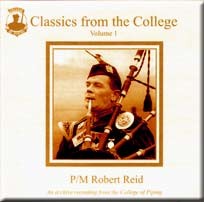
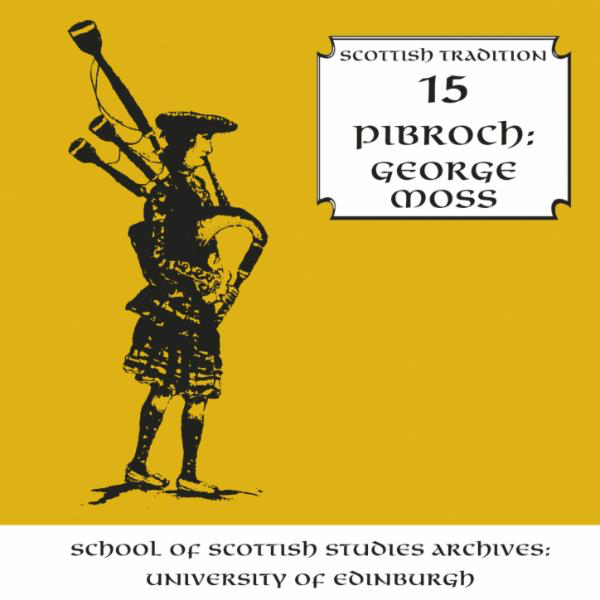 |
|
| About the same time
Hugh MacDonald, then piping producer at the BBC,
arranged for me to meet the late George Moss,
who lived at North Kessock. In common with the
rest of the piping world, I had heard George
being ‘slagged off’ as a crank whose ideas were
beyond the pale. Through his mother, George was a direct descendant of David Fraser, he of the 1743 indenture and composer of ‘Lord Lovat’s Lament’. She was a cousin of Pipe Major Willie Ross. George’s father was a gardener, who like John MacLellan’s, had worked all over the Highlands. While his father was employed on the Glengarry estate, George had come ‘under the influence’ of Sandy Cameron. The story I was told by J.P. Grant of Rothiemurchus was that Sandy had been found on the Embankment in London in very reduced circumstances. His plight was brought to the notice of Captain Allan Cameron, Cameron Highlanders, a brother of Lochiel’s, who was able to arrange for Sandy to be given sanctuary at Chancery and a small pension by Lochiel. Sandy died there in 1923. Captain Allan was killed in 1914. As well as having lessons from Sandy, George had been taught at different times by John MacColl, Angus MacRae, and Norman MacRae, piper to Lochiel’s at Chancery where George’s father was head gardener until retiring in 1938. I am indebted to James Hamilton for the foregoing information. George Moss was no crank. He was an educated, articulate, and intelligent man. He had given up a career in banking to concentrate on piping and the Gaelic language. To cut a long story short, he played and taught what he called the ‘old’ style, which is the style in which the Nether Lorn canntaireachd is written and is to be found on the stave in the MacArthur manuscript, and in Donald MacDonald’s book and manuscript. According to George, and I believe him, the pipers of the generation previous to him had all been aware of this style, and its eventual supercession by that perhaps best described as the Angus Mackay or even the second Piobaireachd Society style. George had in fact given up competing when he realised that his way was not going to be acceptable. He had for some years been in touch with Dr. Peter Cook, then of the School of Scottish Studies, and the School had produced a cassette in the Scottish Tradition series in which George set out and talked about his background and views. It may still be available. For what it’s worth, George, almost blind in his latter days, became a member of the Piobaireachd Society. I commend his cassette to those who take the view that there is no evidence that the MacArthur and MacDonald styles were ever played literally. George taught his nephew, James Hamilton, to play in the old style. James elected to do his National Service in the Cameron Highlanders, in which George had also served until invalided out through poor eyesight. James was rapidly told that what George had taught him was old fashioned and out of date, and that he would have to change if he wanted to play the pipes in the regiment. James conformed, but did not forget what George had told him. Years later, Joshua Dickinson of Anchorage, Alaska, came to James for piping lessons while he was studying Gaelic at the University of Aberdeen. Joshua in due course graduated to piobaireachd, and while James taught him the standard modern idiom, he also took him through what George had taught him about the old style. Joshua, who became a fluent Gaelic speaker, pursued his studies on South Uist. One of the older pipers told him that he had been taught to play the gairm, but had been told that it was old fashioned and out of date. Joshua has written on the subject in this very journal and has also given the John MacFadyen Memorial lecture a couple of years ago. I myself have over the years gathered anecdotal evidence that it was known to the older generation of teachers, and have regretted that at the time when those men were still alive I didn’t know what questions to ask them. This would tie in with Charles Thomason’s statement that the distinction had by 1905 almost vanished, although he refused to concede the point, saying that the gairm had been ‘very marked’ in his early piping days and was still to be heard in Skye. I would agree with him that its disappearance means that ‘a good deal of expression is thereby lost’. Now I am not naïve enough to expect to make any impact on the way piobaireachd is played today, when, as has been said, everyone plays much the same. But I am sad to think that these old ways are being written off as if they never existed, and that these old men are being forgotten. In the same way, the style of ‘The Red Hand’ that Willie MacDonald, Inverness, got from Robert Nicol has died with Willie, and no one will ever play ‘The Bicker’ in the style Robert Brown gave it to me. A generation has grown up in the belief that the whole tradition is encapsulated in the Piobaireachd Society’s series and the Kilberry Book of Ceol Mor. It is not; but as one leading competitor told me years ago ‘don’t give us advice, David; just give us prizes!’ And please, please, spare an old man the lectures! This is my last word on ‘hiharin’ ! |
同じ頃、BBCのパイピング番組のプロ
デューサーだった Hugh MacDonald
が、North Kessock に住んでいた 故 George
Moss に会わせてくれた。私は、パイピング界の他の住民と同様、George が怠け者の変人であり、その考え
方は常識を逸脱していると聞いていた。 George は母方の血筋として、 1743年の年季奉公証書に記載されている、"Lord Lovat's Lament" を作曲した David Fraser の直系の子孫である。母親自身は Pipe Major Willie Ross の従兄弟にあたる。George の父親は庭師で、John MacLellan と同様、ハイラ ンド地方全域で働いていた。父親が Glengarry 農園で働いていたとき、George は Sandy Cameron の「影響下」に居た。 J.P. Grant of Rothiemurchus から聞いた話では、Sandy はロンドンの Embankment 駅で、かなり衰弱した状態で発見されたそうだ。彼の深刻な状況は、Lochiel の兄弟である Cameron Highlanders の Captain Allan Cameron の知るところとなり、彼は Lochiel によって Sandy が Chancery で保護され、わずかな年金が与えられるよう手配することができた。Sandy は1923年にそこで亡くなった。Captain Allan は1914年に戦死している。 George は Sandy からレッスンを受けただけでなく、John MacColl、Angus MacRae、Norman MacRae(George の父が1938年に引退するまで庭師長をしていた Chancery の Lochiel一族のパイパー)から様々な時期 にレッスンを受けている。以上の情報は、James Hamilton の恩恵よる所である。 George Moss は変人など ではなかった。彼は教養があり、明晰で、知的な人物だった。彼はパイピングとゲール語に専念するため、 銀行でのキャリアを諦めた。 長い話を短くすると、彼は彼が 「オールド・スタイル」と呼ぶものを演奏 し、教えていた。それは Nether Lorn カンタラックに書か れているスタイルであり、MacArthur のマニュスクリプトや Donald MacDonald の楽譜集やマニュスクリプトに書かれている 音楽である。 George によると(そして、私は彼の言う通りだと信じているが)彼の前の世代のパイパーは皆このスタイルを認識していたが、最終的には Angus MacKay や第2期のピーブロック・ソサエティーのスタイルに取って代わられたのである。 George は、自分のやり方が受け入れられないと悟ったとき、実質的にコンペティションへの出場を断念した。 彼は何年か前から、School of Scottish Studies の Dr. Peter Cook とやりとりして おり、この組織が制作したスコティッシュ・トラディション・シリーズのカセットの中で、George が自分の経歴や見解について話している。このカセットはまだ入手できるかもしれない。 参考までに、George は晩年ほ とんど目が見えなくなっていたが、ピーブロック・ソサエティーの会員になった。 MacArthur & MacDonald スタイルが譜面通りに演奏されたという 証拠はない、という考えを持つ人たちに、彼のカセットを聴く事を薦める。 George は、甥の James Hamilton に古いスタイ ルの演奏を教えた。James は、 キャメロン・ハイランダーズで国民兵役に就くことを選択した。George もまた、視力の低下により無効となるまで、同隊に所属していた。 James は、George が教えてくれた演奏法は古くて時代遅れであり、連隊でパイプを演奏したければ、変わらなければならないことをすぐに告げられた。 James は忠告に従ったが、George に教えられたことを忘れることはなかった。 数年後、アラスカ州アンカレッジに住む Joshua Dickinson(Dickson?)は、アバディーン大学でゲール語を学んでい た時、James の下でパイプのレッスンを受けるようになる。 Joshua がやがて基礎を卒業しピーブロックに進むと、James は標準的なモダン・イディオムを教 えるが、同時にGeorge から教わった古いスタイルについても指導した。 ゲール語を流暢に話すようになった Joshua は、South Uist で勉強を続けることになった。そこのある年配のパイパーは、gairm を 演奏するよ うに教えられたが、それは古くて時代遅れだと言われたという。 Joshua はまさにこの雑誌でこ のテーマについて書いており("Piping Times" Vol.55/05-2003/02)、数 年前には John MacFadyen Memorial lecture で講演も行っている。(※) 私自身、何年にもわたって、それが古い世代の指導者たちに知られていたという逸話的な証拠を収集して きたが、その指導者たちがまだ生きていた当時は、どんな質問をしたらいいのかわからなかったことを悔や んでいる。 このことは、1905年までにその区別がほとんどなくなってしまったという Charles Thomason の発言と結 びつくのだが、彼はその点を認めようとせず、gairm は彼の初期の パイプ演奏時代 には「非常に顕著」であり、今でもスカイ島で聴くことができると言っている。私は、gairm の消滅という事は「かなりの表現力が失われた事」を意味するという彼と同意見である。 私は、自分が今日のピーブロックの演奏方法に影響を与える事が出来る、と考える程に世間知らずでは無 い。これまで言われてきたように、誰もがほとんど同じように演奏しているからである。 …とは言っても、このような古い手法がまるで存在しなかったかのように書かれ、この古い手法を取る 人々たちが忘れ去られようとしているのを考えるのは、悲しい事である。 同様に、Willie MacDonald, Inverness が Robert Nicol から学んだ "The Red Hand in the MacDonald's Arms" のスタイルは Willie とともに死んでしまったし、Robert Brown が私に教えてくれたスタイルで "The Bicker" を演奏する者はもう居ない。 ある世代は、すべての伝統がピーブロック・ソサエティーの楽譜シリーズと Kilberry Book of Ceol Mor に集約されていると信じて育ってきた。しかし、それは違う。 しかし、数年前、ある有力な競技者は私に「我々にアドバイスなんかしないでくれ、David。ただ賞をくれ!」と言った。 どうか、年寄りの講釈は勘弁だ!…と。 これが ‘hiharin’ について の私の最後の言葉である。 |
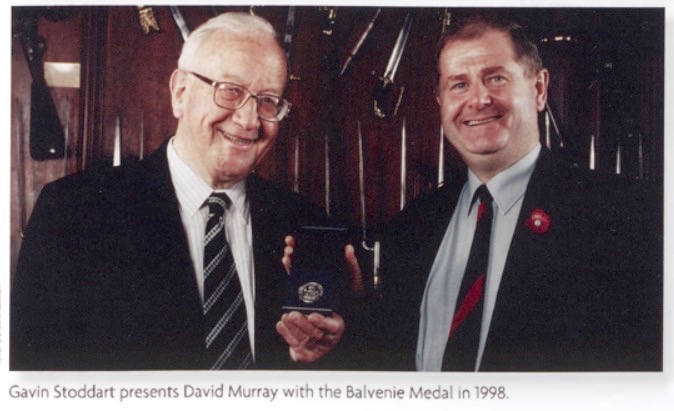 |
|
如何でしたでしょうか?
正直言って、元 PSプレジデントがここまで明確に Kilberrism を批判するというのは少々意外ですが、同時に胸がスッとし、汚れきったハイランド・パイピング界にまともな見識を持った立派な方が居たという事に、ホッと させられます。
やはり、顔(と体型にも?)に人柄が現れていますよね。
さて、この文中でも出てくる、David Murray が PSプレジデント時代、James Campbell の "Sidelights to the Kilberry Book of Ceol Mor" に呈した賛辞の序文が 、実は自らの思い違いによる印象からの物だった、という下りがあります。次のパイプのかおり第53話では、なんと「今と なっては、その序文を取り下げたい」という、その大胆な発言について詳しく紹介します。
※ Joshua Dickson のこの講演録は "Piping Today" No.6-2003/10 と No.7-2003/12 に掲載されています。